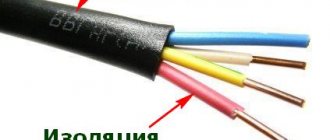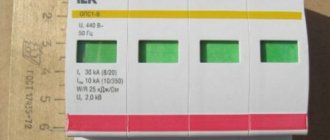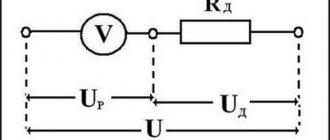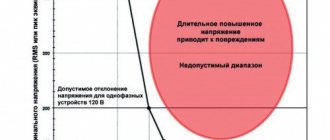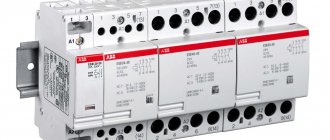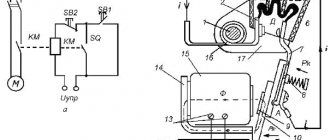Electrician in the house
Encyclopedia about electricity from A to Z
Masters catalog
Find the best master or company in your city
Difavtomats perform a double function (protect against electrical leaks and short circuits) and completely replace the set of RCD and circuit breaker. When choosing a differential, you must consider the following characteristics:
- Circuit breaker rating (A);
- Leakage at which the mechanism is triggered (mA);
- Trip characteristic (“A” or “AC”);
- Type of mechanism (electronic or electromechanical);
- Release characteristics of the machine (B or D).
But how to choose specific values? Taking the opportunity, and not for the first time turning to our electrical engineering expert, I decided to ask him these questions. Namely, the engineer, and part-time specialist in the sale of differential protection, Sergei from the AxiomPlus online electrical equipment store. And this time, although reluctantly, he carried out another educational program.
- How to calculate and determine the right automatic machine for yourself?
- Which release rating should I choose?
- Trip characteristic "A" or "AC"?
- Which type of release should I choose?
- Select the release characteristic of the machine: “B” or “C”
Purpose of differential switches
Differential circuit breakers are designed to protect the electrical network from short circuits and current asymmetry. The operating principle of such devices is based on comparing the values and directions of currents flowing in the L and N conductors of the supply network. If they are equal, then the differential machine remains in the on state. If they are different, it will turn off the load.
Operating principle of a differential machine
A feature of the operation of a differential machine is that in addition to comparing currents with each other, it measures their absolute value. Thus, the differential machine, in addition to the comparing function, performs the task of cutting off the consumer in case of power overload. In this regard, its role is similar to an ordinary circuit breaker.
As a result, we can distinguish 2 tasks that the differential machine performs:
- protection against load imbalance or current leakage to ground;
- disconnection of the consumer in case of overload or short circuit.
It is important to understand the differences between a residual current device and a residual current circuit breaker. The RCD is only used to detect leaks. The automatic differential operates on a similar principle, but additionally protects the network from short circuits and current overloads.
How an RCD prevents fire
For such purposes, special fire safety shutdown devices are used. Their feature is a high leakage current. Its values are selected based on the power of the consumer and normal leakage currents (arising due to aging of the insulation). The approximate values are as follows:
- up to 100 mA - for ordinary consumers, apartments and private houses;
- up to 300mA - for industrial consumers, workshops and small workshops.
In most cases, a fire occurs due to poor contact or poor insulation of the wiring. Current begins to flow through the protective layer of the cable to the surrounding objects. For example, fittings or metal casings of electrical devices. The flow of current leads to heating of the damaged area. Over time, its temperature increases until the insulation ignites.
The role of the fire protection device is to disconnect the consumer in advance when heating leakage currents occur. Subsequently, such a shutdown saves the wiring from fire. And the RCD will not allow voltage to be applied until the damaged area is found and the problem is eliminated.
Additional Information. If the residual current device trips too often for no apparent reason, then you should pay attention to the serviceability of the device itself. There are often cases when the culprit of false alarms is the RCD itself. To avoid such troubles, it is better to purchase automation from reliable manufacturers such as ABB.
Which RCD to choose: 10 or 30 milliamps?
The generally accepted rule here is: 10 mA - for high-risk premises (damp, damp), 30 mA - for ordinary premises. You just need to consider the following. Some authors propose to consider a current as low as 20 mA as dangerous to human life. Naturally, the likelihood of deaths when exposed to such currents is extremely small, but it still exists, so my opinion is this: if there are children at home, whose body resistance is less and the heart muscle is much more tender than that of adults, as well as people with heart disease, It’s better to play it safe and install an RCD with a shutdown current of 10 mA in all rooms. Yes, the condition of the electrical wiring in most apartments, especially those built in the Soviet Union, leaves much to be desired, and household appliances often leak, which increases the likelihood of such sensitive protection being triggered. And here again you have a choice: either spend money on replacing all electrical wiring and repairing faulty household appliances, or expose yourself and especially your children to mortal danger. I chose the first one. Please note: the total leakage microcurrents are never in good working order
electrical wiring and
working
household appliances in an ordinary apartment will not exceed the rated differential shutdown current of a 10-milliamp RCD, especially since any apartment is electrically divided into at least two parts, that is, there will also be at least two RCDs. In large private houses there are even more groups, and for each I recommend installing an RCD with a rated leakage current of 10 mA. Before it, install anything additional - at least 30 mA, even “fire safety” at 100 or even 300, but 10 mA, in my deep conviction, must be present.
It is also necessary to take into account the following point. A circuit breaker installed on the same line as the RCD must have a nominal value no higher (or better yet, one step lower) than the rated current for which the RCD is designed. For example, if an RCD with a rated current of 25 amperes is used, then the machine should have a rating no higher than the same 25 amperes, and preferably 20 amperes. The point here is that the RCD does not have protection against high currents, and if for some reason the current in the circuit exceeds the rated current of the RCD for a long time (and the thermal release of the circuit breaker, as is known, does not operate immediately after exceeding the rated current: it needs time for sufficient heating and bending of the plate), the latter may fail. Therefore, it is recommended to install a machine with a rating one step lower than the RCD rating in order to reduce the possible time of exposure to extreme currents on the residual current device.
The ten-milliamp RCD in my home has never tripped just like that, for no reason. Even when operating a welding inverter and a woodworking machine, my 10 mA RCD never acted up; on the contrary, it is an excellent indicator of some obvious or hidden malfunctions. Here is a recent real case. The washing machine is working. For the first 15 minutes everything is fine, then the 10 mA RCD triggers. Instead of a 10 mA RCD, I install a device rated 30 mA, turn on the machine - it washes a full cycle without problems and heats the water normally. Conclusion: somewhere there is a leak of less than 30, but more than 10 milliamps, and it does not appear immediately after turning on the machine. Logically, the issue here is most likely a defect in the heating element: voltage is not applied to it immediately during washing, but only after the machine pours water into the drum and dissolves the powder in it. This means you need to watch the heating element. I take it out - of course, this is the reason: on the heating element tube in one place there is a tiny through hole, a burnout, through which water entered the tube and touched the energized spiral, which gave a potential to the body of the machine when voltage appeared on the heating element . On the same day, a new heating element was purchased, and a working 10 mA RCD was installed in its place. The problem went away immediately.
So I strongly recommend that you do not save on RCDs, electrical wiring, or repairs of household appliances: life and health are most valuable.
Selection of fire protection device
There are a huge number of different RCD models. Each of them is optimally suited for a specific task. For example, single-phase protective devices are used to protect ordinary apartments, but a three-phase device is already useful for a small workshop.
There is also a difference in the maximum currents that an RCD can pass. For an apartment, a device of 25-32 A is sufficient. For industrial facilities, as a rule, a device of at least 63 A is required, which corresponds to a consumer with a power of about 15 kW.
Therefore, there are a number of criteria by which you should select a residual current device. The most significant of them are:
- Leakage current. For fire models it lies in the range of 100-300 milliamps.
- Electronic or electromechanical RCD. This factor affects the reliability of the device.
- Selective or non-selective device. Depends on the scale and complexity of the scheme.
RCD leakage current
Typical values are 100-300 mA. When choosing, you should proceed from two factors:
- Branching of electrical wiring. The larger it is, the higher the leakage.
- Insulation state. The older, damper and dirtier it is, the worse the leaks.
For an apartment, a 100 mA RCD is used. This is explained by the small branching and overall length of the wiring. After all, the larger the area of cables laid in the walls, the easier it is for current to find a weak spot in the insulation and flow to nearby grounded structures.
Large industrial consumers have more extensive power supply routes. They are also long. Therefore, it is easier for the current to find weak insulation and leave the current-carrying core.
Additional Information. It is worth emphasizing here that current leakage and a short circuit to ground are different things. During a short circuit, the insulation resistance drops to almost zero. Therefore, huge and destructive short circuit currents arise, accompanied by sparks and arcing. Current leakage through insulation is a common and normal phenomenon. Within reasonable limits, it is present even in new electrical cables.
Another important factor that increases leakage current is the condition of the insulation. Moisture, dirt particles, metal dust and cracks reduce the resistance of the protective layer. This usually happens with old wiring. Because of this, current leakage increases. Therefore, if the wiring is old or located in a humid environment, then it is advisable to choose an RCD designed for large leaks.
Electronic or mechanical device
The fire protection devices available for sale are divided into 2 types according to their design:
- Electronic. Contains a small printed circuit board that controls the contacts.
- Electromechanical. They work without complex electronics.
Electronic devices have a disadvantage. For their operation, voltage is required in the protected line. Therefore, if the neutral conductor breaks in front of the RCD, it loses its functionality and does not operate if the insulation is damaged.
Electromechanical devices are more reliable in this regard. They are not so critical to the quality of the supply voltage and are less susceptible to its surges and sags.
Conventional RCD or selective
Conventional protective devices are suitable for small consumers. They are suitable for apartments with a small number of rooms and reliable wiring insulation. The main disadvantage of such devices is the inability to quickly find out where exactly the current leak occurred. That is, if the insulation is damaged somewhere in the apartment, the power supply to the entire area will be turned off.
Selective RCDs are used to form selective protection. Typically these are devices of category S. Their use allows you to localize the location of insulation damage and disconnect only the problem area from the power supply.
Selective device EKF
Selective residual current devices are installed at the input to the electrical panel. They are suitable for large branched consumers or multi-room apartments, in which searching for a current leak can take too long.
Select the release characteristic of the machine: “B” or “C”
The most popular differential models have the following release characteristics: “B” is the most popular option. Characterized by minimal response delay. Suitable for domestic use in houses with old wiring. Not recommended for networks supplying equipment with high starting currents (washing machines, pumps, refrigerators, concrete mixers, etc.). Short-term excess loads provoke the so-called. false alarm. Instantly triggers at currents equal to 3-5 rated; “C” is a universal option, a good solution for private homes. It has a longer delay before operation, so it does not respond to high inrush currents. It is recommended to select for networks with a large accumulation of powerful electrical equipment running on electric motors. Instantly triggers at a load 5-10 times higher than the rated load.
Type “B” is best used for lines without powerful consumers, and type “C” is more suitable for outlet lines with a load of 1 kW or more.
To maintain selectivity, it is advisable to set “C” at the input, and “B” at the outlet lines and lighting, so that in case of short circuits the input differential does not operate before the group ones.
Where is fire protection device used?
Fire protection RCDs are used to protect against fire in apartment buildings. Residents install a protective device in their switchboards at the entrance to the apartment. In this case, the RCD, according to the requirements of the energy supply organization, is installed after the metering device. With rare exceptions, standard fire protection devices with leakage currents of up to 100 mA are used. For an average apartment with modern wiring, this rating is optimal.
Another area of application for a fire protection RCD is protection for a private wooden house. The material of the walls is important here. Wood is more susceptible to burning. It has lower resistivity than concrete. Therefore, in a wooden house, the risk of a fire due to problems with wiring is an order of magnitude higher than in a concrete building. Accordingly, RCD is much more relevant for buildings made of natural materials than for brick or concrete ones.
RCD can also be used as part of more complex fire extinguishing systems. For example, in combination with fire protection equipment from companies such as AAB Technology.
Installation and typical connection diagrams for fire protection RCDs
To install a fire safety residual current device, you will need a minimum set of tools, a little experience in electrical installation work, and a circuit suitable for the consumer. Before installation, you need to refer to the following list of tools and materials:
- pliers, wire cutters, 1-2 m of wire with a cross-section of 2.5 sq. mm;
- indicator screwdriver, multimeter or test light;
- The RCD itself and instructions for its installation;
- suitable connection diagram.
Important! Before installing the protective device, it is necessary to remove the voltage from the electrical panel. To do this, you need to turn off the input circuit breaker, then make sure that there is no dangerous potential using an indicator or voltmeter. Ideally, it is better to use an incandescent test lamp.
There are difficulties in choosing the right scheme. The apartment panel may or may not be equipped with a grounding wire. Some consumers require 3 phases of power to operate, and some only one. Therefore, below are several typical fire protection RCD connection diagrams.
Connecting a single-phase RCD
One of the most popular schemes. It is applicable in apartments and private houses with single-phase power without a ground wire:
- A circuit breaker is installed at the input to the electrical panel. It will protect subsequent circuits from short circuits.
- This is followed by a metering device. In this case it is single-phase.
- Next, the RCD is connected. Installation of wires is carried out according to the markings on the device body.
- After the RCD, the zero should be connected to a common N bus, and the phase diverges among the group circuit breakers.
Connecting a three-phase RCD
To protect a three-phase network from fire, you will need a four-pole 380 V device. The remaining installation principles remain the same. First comes the introductory machine, then the counter and group machines or RCDs.
The main task of a fire protection RCD is to protect wiring from fire. Devices of this class are designed for relatively high leakage currents of up to 300 mA. Therefore, they are not suitable for ensuring human safety from electric shock.
Fire protection RCD connection diagram
The leakage current of a fire RCD is influenced by the condition and age of the wiring. Its length and branching also affects it. The worse the condition of the cables, the higher the risk of false alarms.
RCD in a two-wire network: is it possible?
As a legacy from the “caring and generous” Soviet government, we inherited a two-wire TN-C system, in which the neutral protective and neutral working conductors are combined along its entire length, which is called a PEN conductor. This was done solely for reasons of economy. That government saved pennies on our safety by laying in the access risers not five-, but four-wire cables, which, in addition, were not copper, but aluminum, with all the ensuing consequences: aluminum is brittle, fluid, subject to rapid aging and withstands the same cross-section significantly lower currents and temperature loads than copper. But the Soviets were infinitely generous, spending billions left and right to help numerous “brothers in mind” in all corners of the planet. How many fires there were, how many people were electrocuted because of this economy, and how many more of these things will happen, no one even now knows or wants to know.
The vast majority of apartment buildings to this day have the notorious TN-C and aluminum in risers and apartments. Only a few houses were partially lucky: reconstruction was carried out, and TN-C was replaced with a compromise TN-CS. But even here they managed with half measures: they only changed the cable to five-wire copper and the automatic switches in the staircase panels. Naturally, no one bothered with installing an RCD, replacing apartment wiring with copper and extending a third wire (PE) into apartments: as always, it was very expensive for them... The Soviet Union collapsed. The authorities seem to have made an attempt to turn their face to the people: the new PUE (Electrical Installation Rules) already announced a ban on aluminum and TN-C, but... exclusively for new construction. In old houses, everything remains the same, as if it should be so... But what is most surprising, according to paragraph 1.7.80 of PUE-7, “it is not allowed to use RCDs that respond to differential current in four-wire three-phase circuits (TN-C system). If it is necessary to use an RCD to protect individual electrical receivers receiving power from the TN-C system, the protective PE conductor of the electrical receiver must be connected to the PEN conductor of the circuit supplying the electrical receiver to the protective switching device.” What does this mean in other words? Well, here’s the thing: “You get out of the situation as you wish, and your safety is your personal problem. But WE forbid you to install RCDs in old houses: it’s better without any protection at all than with partial protection.” Well, it’s a very “sound” logic, there’s nothing to say... But the words “if necessary” are especially depressing (as if there were options when with the TN-C system there might not be such a need!) and the requirement to do grounding (!) when using an RCD ! Any adequate electrician knows that the so-called grounding is absolute
: the possible consequences of using zeroing in the event of a zero burnout have long been known, and I will not go into describing the details (those who are interested will find the information on the Internet on their own).
According to ancient tradition, in our country the rescue of drowning people is the work of the drowning people themselves. Those residents who are concerned about their safety and the safety of household appliances install not only RCDs, but also voltage control devices in their apartments (in hallways, at the entrance of wires from the staircase to the apartment) or in floor panels.
So what is the fundamental difference between the use of RCDs in two-wire and three-wire grounding systems? With a three-wire system, the metal housings of all household appliances are connected to a third wire - a PE conductor. In the event of a phase breakdown on the body of, for example, a washing machine, the RCD will instantly cut off the power supply. If the system is two-wire, then the phase will peacefully “sleep” on this body until a person touches it, through whose body a differential current can flow, for example: a person stands in a bathtub with water and at the same time touches a faulty washing machine; or one hand touches the body of a faulty appliance, and the other touches the body of a bathtub, shower, faucet or heated towel rail pipe, etc. In the latter case, a person will feel a weak electric shock - and the RCD will instantly turn off the power supply, which will save the person not only from serious electrical injury, but also his life. So again, choose what is best for you: use an RCD in two-wire wiring or, after listening to the authors of the so-called. PUE, stay forever washing in the bathroom... I chose the first one. And I repeat: this is my personal choice and my own opinion, which I have the right to express, and nothing more.
And everyone makes their own choice.
Most authors of electrical websites are still adequate: they strongly recommend using RCDs in a two-wire system, as they understand that at least some kind of protection is better than nothing at all.
And once on the Internet I came across a generally fantastic argument.
The RCD response thresholds when a differential current appears (10 and 30 milliamps) and their response times are intentional
chosen to prevent the occurrence of fibrillation of the human heart. From which it follows that the RCD is precisely designed to protect a person primarily when the differential current goes through his body, and not exclusively through the PE conductor to the ground, as for some reason the compilers of the notorious PUE decided to prohibit the use RCD without connecting the device housings to the PE conductor. The real shutdown time of high-quality electromechanical RCDs is 30–40 milliseconds (0.03–0.04 seconds), and the differential shutdown currents in reality most often amount to 7 and 22 milliamps in RCDs with ratings of 10 and 30 mA, respectively. Now let's look at the experimentally obtained graph of 0.5% (only half a percent!) probability of cardiac fibrillation when an electric current flows through the human body:
Graph of 0.5% probability of cardiac fibrillation
It follows from it that even if a current of 80 milliamps flows through the human body for 5 (five!) seconds, cardiac fibrillation will occur in only one person out of two hundred, and with a current of 500 (!!!) milliamps, fibrillation will occur in one For a person out of two hundred, it will take a quarter of a second! The calculated resistance of the human body to alternating current with a frequency of 50 Hz when analyzing the danger of electric shock to a person is taken to be equal to 1000 Ohms, although in reality it is most often higher. But let there be a thousand. At 220 volts, the current through the body will be 220 milliamps. Let's look at the graph: with this current, it will take 0.5 seconds for cardiac fibrillation to occur in one person out of two hundred. What kind of 30–40 milliseconds (the response time of a working RCD) can we even talk about here, even if we fantasize that the RCD will open the zero line a little earlier than the phase line?! In my opinion, everything is extremely clear, and further comments are unnecessary.


